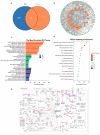AS-IV Attenuates Oxidative Stress-Induced Apoptosis in Zebrafish via Modulation of the AKT/NRF2/HO-1/Caspase-3 Signaling Axis
- PMID: 40509241
- PMCID: PMC12155876
- DOI: 10.3390/molecules30112355
AS-IV Attenuates Oxidative Stress-Induced Apoptosis in Zebrafish via Modulation of the AKT/NRF2/HO-1/Caspase-3 Signaling Axis
Abstract
As the primary active component of Astragalus membranaceus, Astragaloside IV (AS-IV) is widely recognized in pharmacological research for its multifaceted therapeutic potential, particularly its antioxidative, immunostimulatory, and cardioprotective properties. Oxidative stress is an important mechanism in the induction of many diseases. The present study investigates the antioxidative mechanism of Astragaloside IV in zebrafish, using menaquinone exposure to induce oxidative stress conditions. The findings revealed that AS-IV effectively attenuated oxidative stress-induced mortality and morphological abnormalities in zebrafish. AS-IV exhibited a concentration-dependent protective effect against developmental abnormalities, with progressive reduction in pericardial effusion, body curvature, and growth retardation observed at higher doses. Moreover, AS-IV treatment not only effectively reduced reactive oxygen species (ROS) accumulation and attenuated oxidative DNA damage but also significantly decreased apoptosis in the cardiac region of zebrafish embryos under oxidative stress conditions. Western blot analysis revealed that AS-IV treatment significantly reduced the protein levels of both Cleaved Caspase-3 and γ-H2AX, indicating its ability to inhibit DNA damage-induced apoptosis. AS-IV mediates its antioxidant defense mechanisms through the activation of the nuclear factor erythroid 2-related factor 2 (NRF2) signaling pathway, inducing the significant upregulation of cytoprotective enzymes. This molecular mechanism underlies the observed phenotypic improvements in oxidative stress-related damage. Upstream analysis demonstrated that AS-IV activates NRF2 primarily through protein kinase B (AKT/PKB) pathway modulation, independent of KEAP1 regulation. Comprehensive mechanistic analysis reveals that Astragaloside IV mitigates oxidative stress-induced apoptosis in zebrafish through coordinated regulation of the AKT/NRF2/HO-1/Caspase-3 signaling axis.
Keywords: AS-IV; NRF2; network pharmacology; oxidative stress; zebrafish.
Conflict of interest statement
The authors declare no conflicts of interest.
Figures







Similar articles
-
Cytoprotective effect of chlorogenic acid against hydrogen peroxide-induced oxidative stress in MC3T3-E1 cells through PI3K/Akt-mediated Nrf2/HO-1 signaling pathway.Oncotarget. 2017 Feb 28;8(9):14680-14692. doi: 10.18632/oncotarget.14747. Oncotarget. 2017. PMID: 28122344 Free PMC article.
-
Astragaloside IV Regulates the PI3K/Akt/HO-1 Signaling Pathway and Inhibits H9c2 Cardiomyocyte Injury Induced by Hypoxia-Reoxygenation.Biol Pharm Bull. 2019 May 1;42(5):721-727. doi: 10.1248/bpb.b18-00854. Epub 2019 Mar 13. Biol Pharm Bull. 2019. PMID: 30867343
-
Role of PI3K/Akt-Mediated Nrf2/HO-1 Signaling Pathway in Resveratrol Alleviation of Zearalenone-Induced Oxidative Stress and Apoptosis in TM4 Cells.Toxins (Basel). 2022 Oct 26;14(11):733. doi: 10.3390/toxins14110733. Toxins (Basel). 2022. PMID: 36355983 Free PMC article.
-
The cytoprotective effects of 7,8-dihydroxyflavone against oxidative stress are mediated by the upregulation of Nrf2-dependent HO-1 expression through the activation of the PI3K/Akt and ERK pathways in C2C12 myoblasts.Int J Mol Med. 2015 Aug;36(2):501-10. doi: 10.3892/ijmm.2015.2256. Epub 2015 Jun 22. Int J Mol Med. 2015. PMID: 26096841
-
Activation of Nrf2/HO-1 signaling: An important molecular mechanism of herbal medicine in the treatment of atherosclerosis via the protection of vascular endothelial cells from oxidative stress.J Adv Res. 2021 Jul 6;34:43-63. doi: 10.1016/j.jare.2021.06.023. eCollection 2021 Dec. J Adv Res. 2021. PMID: 35024180 Free PMC article. Review.
References
MeSH terms
Substances
Grants and funding
LinkOut - more resources
Full Text Sources
Research Materials
Miscellaneous

